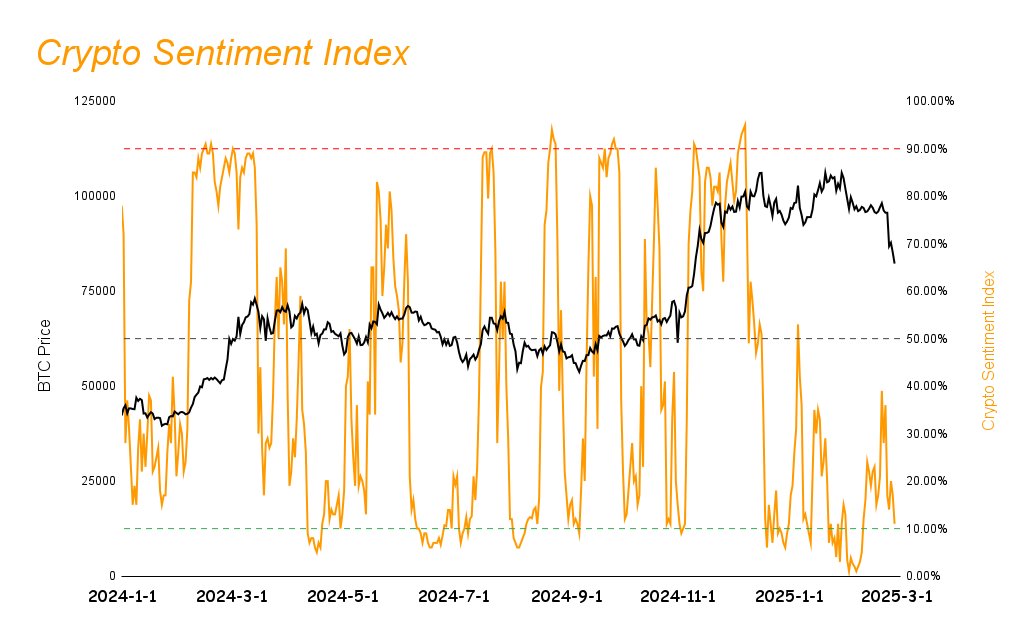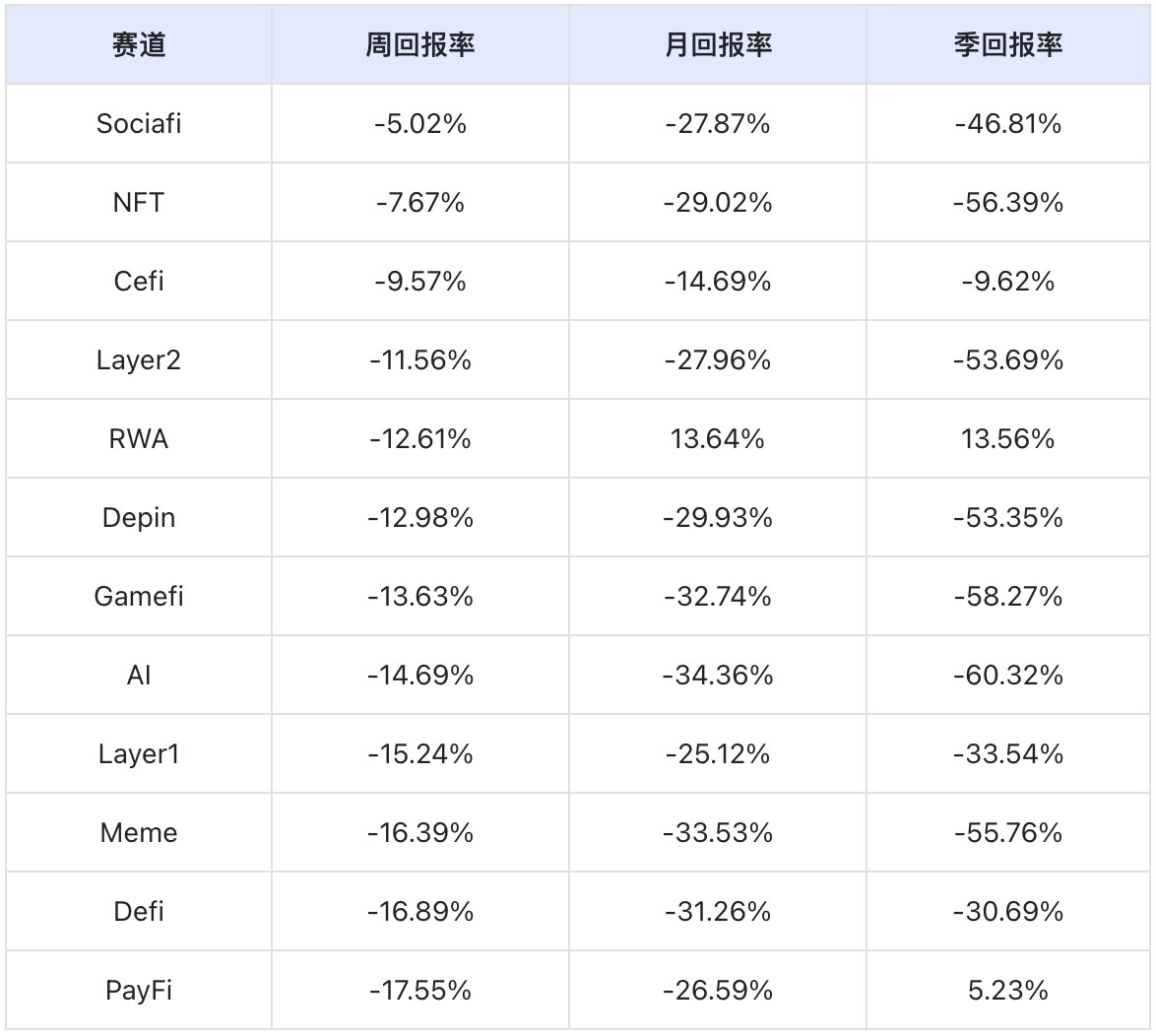RUNE: THORChain is a decentralized cross-chain AMM trading protocol. This week, it experienced a significant upward trend from Monday to Wednesday, mainly due to the hacker who stole from Bybit continuously transferring the stolen ETH to THORChain and conducting money laundering transactions on THORChain, causing a significant increase in THORChain's trading volume and transaction fees. This led to THORChain not following the overall market's downward trend. After the market exposed the hacker's use of THORChain for money laundering, THORChain's developer Pluto announced his resignation, and it is expected that the coin price will continue to decline next week due to the reduction in trading volume and market FUD regarding the alleged money laundering activities.
Market Sentiment Index Analysis

The market sentiment index has declined from 33% last week to 11%, overall in the near-extreme fear zone.
Hot Tracks
Sonic
Current Situation
In the past few weeks, Sonic chain's TVL has maintained a high-speed growth trend, and this week, the TVL of most chains on the chain is in a downward trend, Sonic is the only chain that has maintained a 10% growth rate among the chains with a TVL of over $50 million, with a growth rate of 10.32% this week, and the chain's TVL has grown to $6.83 billion. This shows that even in the extremely bearish market, Sonic's ecosystem is still experiencing continuous capital inflows, and Sonic's token S also rose by 7.63% this week. Although the increase is not high, the fact that it can rise in the context of a market crash also indicates the market's recognition of it.
Reasons for the Heat
Sonic has recently shifted the focus of its project from GameFi to DeFi, adopting a high-APY strategy to attract users on the chain. In its main liquidity projects on the chain, it can provide users with up to 123% APY, and in the lending sector, it provides users with around 10% lending rates, allowing users to achieve a maximum of 100%+ arbitrage APY. In the current downward market, the over 100% APY has a very strong appeal to users on the chain, prompting them to choose to buy or borrow tokens to participate in arbitrage, increasing the demand for the token S, and resulting in a better performance of S compared to most other altcoins.
Future Outlook
We can see from the recent heat of the Sonic ecosystem that it is mainly due to the Sonic ecosystem's LSD projects increasing the annualized yield, attracting more chain users to participate in arbitrage activities. So we can see that the path for an ecosystem to develop rapidly is to achieve efficient driving of its economic flywheel. The project team has shifted its focus to the DeFi track, realizing asset empowerment. In this regard, asset staking and liquidity are the key, allowing assets to generate compound returns in DEX, lending, and asset management. The economic flywheel of the chain ecosystem must be formed through: staking + liquidity + DeFi empowerment + user growth. The core driving force is the dual-wheel drive of the chain's native token staking and liquidity release, allowing it to generate compound returns in scenarios such as DEX, lending, and asset management, realizing "staking is productivity". After users are attracted to the chain ecosystem by high APY, a positive cycle of staking/locking -> liquidity release -> DeFi empowerment -> token appreciation -> user inflow -> re-staking -> developer aggregation must be formed. Otherwise, if the capital of new entrants is insufficient to cover the selling pressure of arbitrageurs, the token price will decline, and the yield of various projects will inevitably decrease, causing the arbitrageurs to exit. This would be a huge blow to the ecosystem, so we need to continue to pay attention to the APY of DeFi projects on the Sonic chain in the future to judge whether it still has the power to develop.
However, it is worth noting that although Sonic's TVL was the fastest growing among all chains with over $100 million this week, its TVL did not rise steadily, but experienced a rebound after a high.
Berachain
Current Situation
This week, the entire market was in a rapid downward trend, and the top 10 projects by TVL, except for Berachain, were all in a downward trend. Although Berachain's TVL increase this week was only 4.66%, it is still not easy to maintain positive growth in the current environment, with a TVL of $31.94 billion, ranking sixth among all public chain TVLs, surpassing Base chain. Its token BERA also maintained an upward trend this week, with an increase of 7.26%, in a strong position among altcoins.
Reasons for the Heat
This week, the growth rate of the TVL of Berachain's top DEX, Lending, and LSD projects has slowed down, and Berachain's TVL even declined in the first half of the week. However, due to the fact that Berachain's main LSD project Infrared Finance has raised the APY of WBERA to a maximum of 121%, and the emerging LSD project Stride has raised the APY to 190.12%, while the lending rate for borrowing BERA on Berachain's lending projects is 23.68%, allowing arbitrage users to earn a 100% risk-free annualized return, this quickly curbed the downward trend and turned it into an upward trend.
Future Outlook
Berachain's continued heat this week is mainly due to the increase in APY of its DeFi projects, which continues to have a strong appeal to users on the chain, causing a large amount of chain users to invest their funds in Berachain. Berachain's development path is similar to Sonic, so the problems it faces are also similar to Sonic. At the current stage, Berachain has realized the process of staking/locking -> liquidity release -> DeFi empowerment -> token appreciation, but it has not shown outstanding chain projects in the process of user inflow -> re-staking -> developer aggregation. Therefore, although this high-yield model can enable the Berachain ecosystem to develop rapidly in the short term and promote the rapid rise of the project token BERA, it will inevitably face increasing selling pressure in the future. When the capital of new entrants is insufficient to cover the selling pressure of arbitrageurs, the BERA token price will decline, and the yield of various projects will inevitably decrease, causing the arbitrageurs to exit. Therefore, in the future, we should pay more attention to whether there are new star projects appearing on the Berachain chain, as well as whether the interest rates of LSD projects on the chain have dropped significantly.
Overall Market Theme Overview

Data Source: SoSoValue
Based on weekly returns, the Sociafi track performed the best, while the PayFi track performed the worst.
Sociafi track: In the Sociafi track, TON and CHZ account for a relatively large proportion, totaling 95.17%, and their declines this week were -4.86% and -4.79% respectively, which, although in a downward trend, were still better than the performance of other altcoins, leading to the best overall performance of the Sociafi track index.
PayFi track: In the PayFi track, XRP, LTC, and XLM account for a relatively large proportion, totaling 94.62%, and their declines this week were -19.23%, -1.21%, and -16.96% respectively, causing the PayFi track to perform the worst.
Preview of Major Crypto Events Next Week
Monday (March 3): US February ISM Manufacturing PMI
Wednesday (March 5): US February ADP Employment; Pectra network upgrade plan launched on Ethereum testnet
Friday (March 7): US February Seasonally Adjusted Non-Farm Payrolls; US February Unemployment Rate
Summary
This week, the cryptocurrency market experienced a significant decline, with the market sentiment index plummeting, indicating widespread investor concerns. However, some projects such as LTC, Sonic, SoSoValue, and Berachain have attracted users through high-APY strategies. In the long run, market stability and the emergence of new projects will be key factors. Investors are advised to closely monitor market dynamics and operate cautiously.








